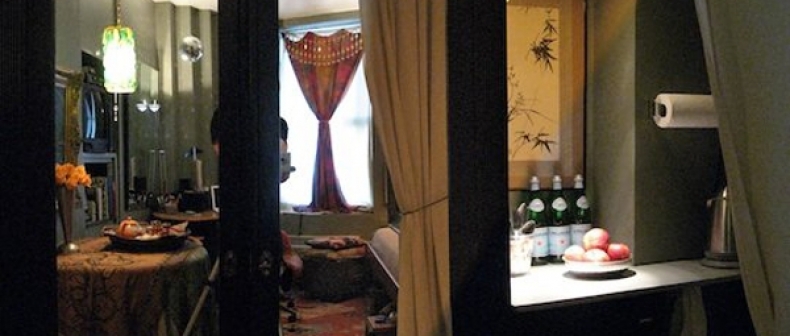
You really want to be a grown-up urbanite? Get a tiny condo, the tinier the better.
News has hit the papers that Toronto will soon be home to a few 270 square foot condos, and that in Vancouver a former rooming house has had its rooms converted into apartments ranging in size from 226 to 291 square feet. People are concerned. Where are we headed? What will become of us?
There’s this notion out there that adults buy cars and get increasingly large homes as a result and reflection of their increasing success and prosperity.
That is a distinctly suburban way to think about adulthood. And you’re not sub anything are you? I didn’t think so.
Here’s the skinny: great cities are made up of well used, well kept public spaces and retail businesses that are held to a high standard by a demanding public. If you’re perfectly happy with a pub that serves skunky Blue, you will have them in abundance.
But no one likes skunky Blue, you say. You’re right, but there is a class of person who will put up with skunky Blue: the occasional patron. If you only ever stop by this or that bar when something else fell through, or when you have to wait for a tow truck for your Escalade, you’re not going to care too much, and the skunkiness of your brew is not going to be a determining factor in whether that bar gets your repeat business.
You know who does care about skunky Blue? People without cases of Blue in the fridge at home. These people outsource their beer drinking. They usually pick up a favourite local spot in the process, sometimes several. These people also, eventually, will notice that funny-looking boot-shaped tap beside the Blue tap at the bar and, after a dozen visits or so, will ask the bartender what that is. Wellington? Oh, I get it, the boot’s like a Wellie. Funny. Let me try one of those. That doesn’t taste like Blue. That tastes good. Ale, you say? Do you have any more of these so-called “ales”?
And do you know who doesn’t have a case of Blue at home in the fridge? Someone whose fridge is too small to hold a case of Blue. And the most likely reason someone might have such a small fridge is that they have a small kitchen, in a small condo.
Why would anyone intentionally choose to have a small place when they can afford a larger one? Because they want to live in a great city. There’s a cause and effect relationship between the two, and you will never get one without the other. If you spend your money on homely comforts like large spaces, comfy furniture, 60-inch TVs, kitchen islands and big fridges, you will be far more likely to spend your leisure time at home, either by yourselves or in a stream of swapped dinner parties meant to revel in your social circle’s admirable creature comforts and good taste. And that can be lovely, like The Ice Storm was lovely. Did you see The Ice Storm? Lovely, lovely homes.
But let’s say you don’t buy that big comfy couch for $2,000, or that 60-inch TV for another $2,000, or pay that $15,000 premium on the purchase price of your condo for the $4,000 worth of stainless steel appliances. Let’s say you keep those things for about five years before you need new ones. And let’s say you don’t buy a car, and that the car you don’t buy is a Honda 2012 Civic Coupe that would cost you $370 a month in financing and another $300 a month for insurance (and let’s say we forget about parking and maintenance and tickets).
Without the comfy stuff to keep you indoors and without the average car, you would have an extra $32 a day to spend on your ale, or a good supper, or a play, or art, or whatever you like. That’s $32 a day if you go out 365 days a year. That’s $224 a week you would be investing in your city instead of your kitchen and living room.
Let that number sink in. And remember, that’s on top of whatever you spend on such things at the moment. You could repeat your Wellington experience across a number of bars, and some restaurants as well. You could go to Le Paradis for lunch every day of the week. Or you could save up and go to The Hoof or Fressen every second night for dinner, and cap it off with a trip to the Cocktail Bar. The owners of Le Paradis, The Hoof, Fressen and the Cocktail Bar would like this quite a bit. Soon, they would be very crowded, and would be turning people away. And that would not go unnoticed by the city’s restaurateurs, who would open up more restaurants and bars of similar or superior quality to cater to the overflow. Before you know it, we might have several good cocktail bars, and two or three good restaurants to choose from on a given block.
You wouldn’t have to spend it all on food and drink, of course. You could indulge your hydrangea habit, giving a boost to those flower shops Woodcliffe is proposing for their new and improved Market Street. You could buy more Japanese paper, too, if that’s your thing, or develop your nascent taste for Teuscher chocolate, or better yet, Stubbe. That $224 a week (which, to save you doing the math, works out to about $900 a month) goes a long way.
And imagine a whole race of tiny condo dwellers, all investing their $900 a month in their city, giving business owners more and more incentive to open new and better places to give you things in exchange for that money. And it could be a very big race, indeed, since smaller condos mean more condos and more condos mean more people. According to Realnet president George Carras, the current average size for a high-rise home in the GTA is 820 square feet. That number is headed in the right direction, down 100 square feet from 2009, and down 52 square feet from last year. But there’s still a way to go before approaching the size of the current smallest condo in the city, which belongs to real estate agent Andrew Lafleur and is 301 square feet.
Some might see the shrinkage of our personal, private space in dystopian terms. But if we’ve learned anything from the great 20th-century suburban experiment is that public and private space exist on opposite ends of a big see-saw from each other. Ranch homes with big yards mean no corner stores. The sunken living room comes at the expense of a local pub. Double garages ensure that drive-through doughnutteries win out over stroll-through neighbourhoods.
But if you forswear the wall-to-wall carpeting and Corinthian leather and start treating your neighbourhood park as your living room, your diners and restaurants as your kitchen and dining room and theatres and cinemas as your TV room, if you spend you money on living rather than nesting, there needn’t be anything small about urban life.
____
Bert Archer writes about media and real estate for Toronto Standard. Follow him on Twitter @bertarcher.
For more, follow us on Twitter at @TorontoStandard, or subscribe to our newsletter.














